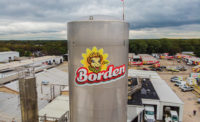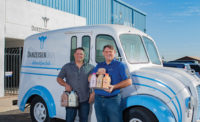The past year brought a sea of positive changes to Borden Dairy Co. The Dallas-based company welcomed a new CEO — Tony Sarsam, who boasts more than three decades of experience in the food industry at major companies that include Frito-Lay, Nestlé and PepsiCo — as well as a handful of other key executives. It also entered the planning stages for three major growth initiatives tied to innovative new product development, enhanced service capabilities and strategic acquisitions.
Those changes, along with a new commitment to be a “people-first” organization, have energized and excited employees at the 161-year-old company, which is perhaps best known for its iconic Elsie the Cow mascot.
It should come as no surprise that employees are embracing the transformation in progress. After all, Borden Dairy has a complicated history that has included some less-sunnier times. Founded in 1857 by Gail Borden, the company grew and became a trusted household name by the early part of the 20th century, Sarsam noted. In 1936, Borden Dairy took its first major marketing step by introducing Elsie the Cow.
“The company grew to be quite large; it had its foundations in dairy, but was a conglomerate,” Sarsam explained. “And like a lot of other companies that grew up in the 20th century, it took on things that were beyond the immediacy of its fundamental offerings.”
By the 1990s, Borden Dairy found itself in financial trouble, he said, and it was acquired by New York-based Kohlberg Kravis Roberts & Co. (KKR). KKR sold off many of the divisions and brands — and the Borden Dairy that Americans knew and loved pretty much ceased to exist.
Much of Borden Dairy’s dairy operations eventually were acquired by Grupo Lala of Mexico, Sarsam noted. And in 2011, Grupo Lala changed the name of its Dallas-based LaLa-USA operations back to Borden Dairy Co. Borden Dairy subsequently was spun off in 2013 into the privately held Grupo Lala-owned Laguna Dairy, S.A. de C.V.
To Borden Dairy’s benefit, however, ACON Investments, Washington, D.C., became an investor in the company in 2017. And ACON has big plans for the 3,500-employee company.
“Borden is an iconic brand with more than 150 years of heritage,” said Aron Schwartz, managing partner of ACON, at the time of the investment announcement. “We are excited to be partnering with Laguna Dairy and Borden’s management to accelerate the company’s growth and maintain its position as a market leader.”
The goal, Sarsam said, is to create “a really fine company” that’s built on Borden Dairy’s rich history, trusted brand and products, and existing and new employees.
“We are shepherding that mission in a different way than it had been guided in the last quarter of a century,” he explained. “We have to fill voids in departments and capabilities. And we’re pretty aggressively doing that right now.”
An impressive framework on which to build
On the product front, Borden Dairy already manages approximately 1,200 items produced in the company’s 13 processing facilities and another nearly 800 items that are purchase-for-retail offerings, noted Kevin Gallagher, chief supply chain officer. Gallagher is a 30-year-plus food industry veteran who left Fairlife LLC a little over a year ago to join Borden Dairy.
Borden’s own products include fluid milk, cream, half & half, buttermilk, cottage cheese and dairy dips, as well as some nondairy offering such as ready-to-drink tea and juices, he said. In addition to retail outlets such as grocery and convenience stores, Borden counts schools and foodservice among its customers.
But fluid milk, in all fat levels and in flavors that go beyond just white, remains the company’s staple item, accounting for the majority of its sales, stressed Joseph DePetrillo, chief marketing officer. DePetrillo is one of the newest members of the executive team, but honed his sales and marketing expertise at companies that include Johnson & Johnson, Danone and Nestlé.
Gearing up for innovation
Going forward, Borden Dairy’s product innovation initiative will stay true to the company’s dairy roots, DePetrillo noted. The selling point will be the “goodness of real dairy” in relation to both nourishment and taste indulgence.
And the target consumer demographic will continue to be what has been the lifeblood of Borden Dairy’s business: households with children under 12, he pointed out.
“The millennial mom is the core target for us as a buyer for both consumption by adults and by families with children,” DePetrillo said.
What’s more, Borden Dairy is looking to connect more closely with this demographic via the value-added side of dairy, Sarsam noted.
“We have tremendous trust associated with the brand,” he said. “But fundamentally, the bulk of our product line right now is competing in what is undoubtedly a highly commoditized space — fresh fluid milk. So that’s where we’re focusing our innovation strategy — on additional value-added.”
To succeed here, Borden Dairy is taking a step-by-step approach to product innovation efforts. The company has already identified
its strategy, the territories in which it wants to compete and what the Borden brand stands for. In-depth focus groups were a big part of
that effort.
Now the company is engaged in concept development and validation, DePetrillo noted. It recently brought together a broad internal cross-functional group for brainstorming and product ideation.
“Then we’ll converge and select ideas to test,” he added. “Next, we’ll do concept testing, as well as an internal feasibility assessment.”
Once all of that initial work is completed, Borden Dairy will re-evaluate the concepts and enter stage two of development process, DePetrillo explained, which will involve formulation development and market opportunity refinement. Stage three will take any concepts closer to launch by finalizing the P&L and market sizing. Stage four, meanwhile, will be the actual launch of the concepts.
But existing favorites will still have their place in Borden Dairy’s efforts to reach target consumers. For example, the company is very proud of its chocolate milk.
“We have it on high authority that it is absolutely the best in the world,” Sarsam said. “It is a terrific replenishment for athletes and for kids. It has a great load of vitamins. And obviously it’s delicious to drink from a flavor standpoint. So we think it’s a tasty manifestation of something that’s fundamentally good.”
Elsie the Cow is also a keeper — the mascot, which DePetrillo calls “a cool mom,” will be critical in planned social media and other marketing campaigns that aim to connect consumers to new and existing Borden brand products. Research has shown that even though Borden Dairy hasn’t communicated much about Elsie (or about the Borden brand itself, for that matter) in recent years, consumers still loosely associate her with the brand, DePetrillo noted.
“She’s universally beloved,” he said, “and she’s a happy cow. … She’s not dated. Consumers really see Elsie as someone of today that they can still relate to.”
Beyond product innovation
Although the product innovation piece certainly will be the most visible of the three-pronged strategy, service enhancements and acquisitions will be arguably just as important to growth.
“Innovation is going to be critical,” Sarsam said, “and it’s not just product. It’s in everything we do. It’s seeking constant improvement, having a continuous learning organization and constantly improving.”
On the service side, that will mean delivering to retailers not only new products, but also shopper marketing ideas, he said. Messaging that increases penetration during the holiday season, back-to-school and other key moments will be important, too.
“One thing that we know that a great many of our retailer customers would like to have is delivery of milk in something other than a milk crate,” Sarsam added. “So another thing we’re doing is installing corrugate lines [in our plants] that actually will package the milk in a cardboard one-trip/one-usage pack. It’s a great way for us to provide helpful and efficient service for our customer base.”
The automated corrugate lines will be a substantial change for the company and the industry, Gallagher noted. Right now, Borden is either manually or semi-automatically loading the product into the corrugate packaging because the existing line setup places the milk into milk crates first.
“So these new lines are high-speed automated and tied directly to the filler, so there’s no more manual intervention in the middle,” he explained. “And they run at three times the speed that we currently do today.”
On the acquisition front, Borden primarily will be eyeing dairy businesses. But the company will be exploring other possibilities, too, Sarsam said.
“Fundamentally, we provide healthy beverages,” Sarsam said. “There are nondairy types of expressions that could be interesting acquisitions for us in that space.”
Investing in technology, employees
To help support its growth initiatives, Borden Dairy has been making investments its processing facilities that go beyond the automated corrugate lines. For example, at its Dallas plant, the company invested more than $1 million in the past year in automation related to process control, Gallagher said. (See the Inside the Plant story)
“Going forward, we’re going to be moving into the packaging end with automation to improve efficiencies and improve the work environment for the employees,” he said.
Borden Dairy’s other 12 plants also have been the beneficiaries of automation-related and other investments and are in varying stages of modernization, he added.
But perhaps the most important investments for Borden Dairy right now are the ones it is making in its people. As Sarsam stressed, the company has stated its intention to be a people-first organization.
“We are spending a lot of our energy on communicating and taking this organization to a place where all employees feel they have an important role and they’re engaged and feel respected,” he said. “As far as our guiding principle, that’s where most of our energy is going to be placed.”
Accordingly, the company’s social responsibility initiatives are primarily determined by the employees, who Sarsam said are already very active in charities and civic programs. And Borden Dairy’s board will take on responsibility for helping employees further their causes.
This people-first approach recently played out positively in Borden Dairy’s response to the recent hurricanes (Michael and Florence). Two of the company’s plants were impacted, and employees worked diligently to bring them back online in less than two days.
“More importantly, we were able to help in the local community,” Sarsam said. “We provided a series of loads — 220,000 units of milk, tea, water, and juice to folks who needed it. … That is both important to our people and a real source of pride for how we are viewed in our communities.”
Rolling with the changes
In its quest to grow, however, Borden is not immune to the challenges impacting the overall dairy industry. But the company chooses to view most of those challenges as opportunities.
One such challenge is declining Class I milk sales, noted Richard Thomas, chief procurement officer. Thomas has been with Borden Dairy since 2012.
“But there is still opportunity,” he said. “Puralite is a great example of innovation creating excitement around the category and creating an increase in drinkable milk. … Now it’s just figuring out how we can provide products that will really engage with our consumers and provide excitement among our customers to help us to continue on the growth trajectory.”
As the popularity of plant-based beverages continue to grow, fighting misconceptions around dairy is another issue, DePetrillo said. He added that milk is really underappreciated when it comes to the role it’s long played in nourishing American families.
“It’s the No. 1 source of potassium, calcium and vitamin D, and a great source of high-quality protein,” he said. “Yet we see the plant-based beverages continuing to grow. … We want to work closely with our industry partners and associations to tout the benefits of milk.”
Closely tied to that issue is the fact that the dairy industry is highly regulated in comparison to the plant-based beverage segment — and many other food and beverage sectors, Sarsam said. (And the use of “milk” in the labeling of many plant-based beverages is confusing to the consumer, he added.)
“The big message out there is about being nimble — consumers’ tastes are shifting very quickly,” he said. “The industry has to be able to move with those things and address them. And I don’t think we’ve demonstrated great ability in that space as an industry.”
On the supply chain side, the need to deliver a longer shelf life to customers also is a challenge, Gallagher noted.
“We have to run better; we have to find new efficiencies; we must optimize how we handle and move products,” he said. “And, of course, we could explore extended shelf-life [products] potentially in the future.”
The highest-quality raw milk is critical to the shelf-life issue, too, Thomas said. The more Borden Dairy can partner with farms and work with its suppliers to ensure that quality, the better. Right now, the company has a relationship with approximately 300 dairy farmers, as well as with a number of major milk cooperatives.
“We’re proud to say that 100% of our farms are audited and approved under the latest animal care standard,” he added. “And we want to keep a close relationship with National Milk [Producers Federation] to make sure we are doing our part on that as well.”
Positioned for success
Challenges aside, Borden Dairy seems well-positioned for a major comeback. Expect to see big things from the company in the not-so-distant future, including a still-excited and still-engaged workforce that’s building on the innovation, wins, success and efficiencies it’s achieved, Thomas suggested.
“A year from now, we will be well underway in terms of distinguishing ourselves from an innovation standpoint,” Sarsam predicted. “We’ll have products that are actually starting to resonate with both customers and consumers and will be making a statement about Borden in new and important food areas within the dairy category.
“We’ll have a team that continues to be engaged and is working on greater efficiency and effectiveness in terms of running the company and serving our customers,” he said. “And we’ll be on our way.”









